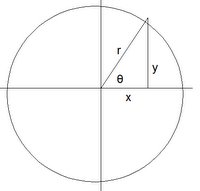The content in today's blog is taken from Jean-Pierre Tignol's Galois' Theory of Algebraic Equations.
Lemma 1: The periods of two terms are (2 cos 2kπ/p) for k = 1 ... (p-1)/2
Proof:
(1) ηj = ζj + ζ[j + (p-1)/2] [See Definition 3, here where e = (p-1)/2 and f = 2]
(2) ζ[j + (p-1)/2] = (ζj)g(p-1)/2 [See Definition 1, here]
(3) g(p-1)/2
(a) (g(p-1)/2)2 ≡ gp-1 (mod p)
(b) gp-1 ≡ 1 (mod p) [By Fermat's Little Theorem, see here]
(c) Thus, g(p-1)/2 ≡ ± 1 (mod p)
(d) But since g is a primitive root modulo p (see D! efinition 2 and Definition 4, here) and since (p-1)/2 is less than p-1, it follows that g(p-1)/2 ≠ 1.
(e) Thus, we have that g(p-1)/2 ≡ -1 (mod p).
(4) So, we have ηj = ζj + ζj-1 [See Lemma 1, here]
(5) We can expre! ss the p-th roots of unity as solutions to Φp(x) such that they are the solution to:
xp-1 + xp-2 + ... + 1 = 0 [See Lemma 1, here]
(6) The trigonometric solution for the equation above are (see Corollary 1.1, here):
cos 2kÏ€/p + isin 2kÏ€/p where 1 ≤ k ≤ p-1.
(7) For ζj, there exists an integer m such that:
ζj = cos 2mπ/p + i sin 2mπ/p
(8) Using Lemma 4, here, where u= 2mπ/p, we have:
ζj + ζj-1 = cos 2mπ/p + i sin 2mπ/p + cos 2mπ/p - isin 2mπ/p = 2 cos 2m π/p.
QED
Theorem 2: If p is a prime number of the form p = 2m+1 (with m ∈ N) then the regular polygon with p sides can be constructed with ruler and compass.
Proof:
(1) Since p=2m + 1, p-1 is a power of 2.
(2) We can thus view p-1 as a chain of multiplications such as:
1 → 2 → ... → 2m-2 → 2m-1 → 2m
(3) Using a previous result (see Lemma 5, here), we can see that the chain of multiplication in step #2 shows that the periods of two terms can be determined by solving a sequence of quadratic equations.
(4) The periods of two terms are the values 2 cos 2kπ/p for k = 1 ... (p-1)/2 [See Lemma 1 above]
(5) Since the solution of a quadratic equation only requires rational operations and extraction of square roots (see Theorem, here), it follows that cos 2Ï€/p can be obtained from 0 and 1 by rational operations and extractions of roots.
(6) So, using Wantzel's Constructibility Criterion (see Theorem 5, here), it follows that (cos 2Ï€/p, 0) is constructible.
(7) Let A be a point at (0,a) and O at (0,0) such that we take OA as one unit of measurement and circle
(8) Point P0 = (cos 2Ï€/p, sin 2Ï€/p) is obtained in the following way:
(a) Let Q be the point at (cos 2Ï€/p, 0) that we showed was constructible in step #6 above.
(b) Let QP0 be a line that is perpendicular to OQ and where P0 intersects with the unit circle OA. [See here for Euclid, Book I, Proposition 11 whic! h shows this construction]
(c) Now, we can see that P0 is at (cos 2Ï€/p, sin 2Ï€/p) since:


By the diagram above:
x = cos 2Ï€/p
r = 1
Since cos θ = (cos 2π/p)/1 = cos 2π/p, we have θ = 2π/p.
Also, we have: sin θ = sin 2π/p = y/1 ! = y
(9) The point P0 is a vertex of the regular polygon with p sides. The line AP0 forms one side of the polygon, so we can label point A as P1.
(10) We can find the other p-1 sides in the following way. Let P0P1 be a circle at point P1 with radius equal to P0P1 (see Postulate 2, here). Call P2 the point where circle P0P1 intersects with unit circle OA (and is not point P0). We can repeat for circle P2P1 (finding point P3), circle P3P2 (find point P4), etc. until we have constructed our regular p-sided figure.
QED
Corollary 2.1: A regular polygon with n sides can be constructed with a ruler and compass if n is a product of distinct Fermat primes and a power of 2.
Proof:
(1) A regular polygon with n sides is constructible when n is a Fermat prime. [By Theorem 2 above]
(2) Since we can always do a repeated bisection of angles (see here for Euclid's Elements, Book I, Prop 9), a regular polygon with n sides is also constr! uctible when n is a po! wer of < span style="font-weight: bold;">2.
(3) So, to complete this proof, we only need to show that if n1 and n2 are relatively prime and a polygon with n1 sides is constructible and a polygon with n2 sides is constructible, then it follows that a polygon with n1n2 sides is constructible.
(4) Since n1, n2 are relatively prime, there exists! integers m1, m2 such that (see Lemma 1, here):
m1n1 + m2n2 = 1.
(5) Multiplying both sides by 2Ï€/(n1n2) gets us:
m1(2Ï€/n< /span>2) + m2(2Ï€/n1) = 2Ï€/(n1n2)
(6) Therefore using Wantzel's Criterion (see Theorem 5, here), it follows that 2Ï€/(n1n2) can be constructed by repeating a certain number of times 2Ï€/n1 and 2Ï€/n2.
(7) It therefore follows that the regular polygon with n1n2 sides can be constructed from regular n1 polygon and a regular n2 polygon.
QED
References
- Jean-Pierre Tignol, Galois' Theory of Algebra! ic Equations
, World Scientific, 2001
regular polygon angles
No comments:
Post a Comment